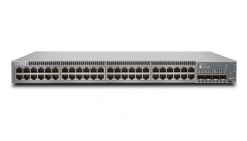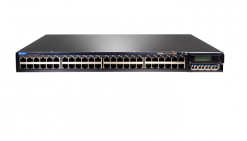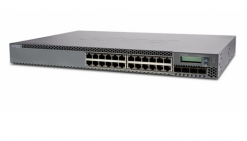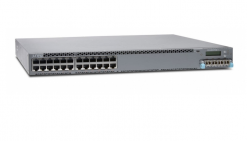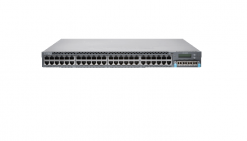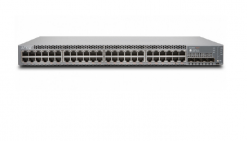Switch Juniper EX4550 32 Port 100/1G/10GBASE-T
Liên hệ đặt hàng
Category: Switch Juniper
Tags: switch juniper, thiết bị mạng juniper
Thông số kỹ thuật Switch Juniper EX4550-32T-AFI
| Hardware Specifications | |
| Interface Options | • 32 100M/1GBASE-T/10GBASE-T RJ-45 auto-negotiating ports • 16 10GbE SFP/SFP+ (MACsec 802.1AE capable) ports (via two optional 8-port expansion modules) • 16 100M/1GBASE-T/10GBASE-T ports (via two optional 8-port expansion modules) • 128 Gbps Virtual Chassis module with 2 x 64 Gbps ports • 1 x 10/100/1000 Ethernet RJ-45 ports for management • Console port for management |
| Dimensions | • Height: 1.72 in (4.37 cm); 1 U • Width: – 17.35 in (44.07 cm) without front-mounting brackets – 19 in (48.3 cm) with front-mounting brackets • Depth: 18.5 in (46.99 cm) • Weight: – EX4550 switch with 1 AC power supply: 19.4 lb (8.8 kg) – AC power supply: 2.4 lb (1.1 kg) – DC power supply: 2.4 lb (1.1 kg) |
| Rack Installation Kit | Versatile two- and four-post mounting options for 19-in server rack or datacom rack |
| LEDs | System LEDs that indicate status |
| CPU | 1.2 GHz |
| Memory | 2 GB DRAM, 2 GB flash |
| Switching Engine Model | Store and forward |
| Power | Dual hot-swappable load sharing AC and DC power supplies |
| Software Specifications | |
| Security | • RADIUS • TACACS+ • Access control lists (ACLs): Allow and deny • SSH v1, v2 • Secure interface login and password • Local proxy Address Resolution Protocol (ARP) • Static ARP support |
| Layer 2 Features | • Maximum number of media access control (MAC) addresses in hardware: 32,000* • Jumbo frames: 9,216 bytes • Number of VLANs: 4,096 • Port-based VLAN • 4,096 VLAN IDs supported • Routed VLAN interface (RVI) |
| Spanning Tree | • Rapid Spanning Tree Protocol (RSTP) and VLAN Spanning Tree Protocol (VSTP) running concurrently • Spanning Tree Protocol (802.1D) • Multiple Spanning Tree Protocol (MSTP) (802.1s) • RSTP (802.1w) • VSTP – VLAN Spanning Tree • BPDU protect • Loop protect • Root protect |
| Link Aggregation | • 802.3ad support – Number of LAGs supported: 64 – Maximum number of ports per LAG: 8 • LAG load-sharing algorithm—bridged or routed (unicast or multicast) traffic: – IP: S/D IP – TCP/UDP: S/D IP, S/D Port – Non-IP: S/D MAC – Tagged ports support in LAG |
| Quality of Service | • EZQoS • Class of service (CoS) on L3 VLAN • Per interface rewrite • Per interface classification • Policer mark down action • Remarking of bridged packets • Layer 2 QoS • Layer 3 QoS • Rate Limiting: – Ingress policing: 1 rate 2 color – Egress shaping: Per queue, per port – 8 hardware queues per port – Scheduling methods (egress): Strict priority (SP), shaped-deficit weighted round-robin (SDWRR) – 802.1p remarking – L2-L4 classification criteria: Interface, MAC address, Ethertype, 802.1p, VLAN, IP address, DiffServ code point (DSCP)/IP precedence, TCP/UDP port numbers, etc. – Congestion avoidance capabilities: Weighted tail drop eight queues |
| Layer 3 Features: IPv4 | • VRF-lite (IS-IS, RIP, OSPF, BGP) • IP directed broadcast traffic forwarding • Routing protocols: RIPv1/v2, OSPF, BGP, IS-IS • Maximum number of IPv4 unicast routes in hardware: 14,000* • Maximum number of IPv4 multicast routes in hardware: 4,000 • Static routing • Routing policy • Virtual Router Redundancy Protocol (VRRP) • Bidirectional Forwarding Detection (BFD) protocol |
| Layer 3 Features: IPv6 | • Maximum number of Neighbor Discovery Protocol (NDP) entries: 1,000 • Maximum number of IPv6 unicast routes in hardware: 3,400* • Maximum number of IPv6 multicast routes in hardware: 1,000 • Routing protocols: RIPng, OSPFv3, IPv6, BGP, MLDv2 • Static routing |
| Multicast | • VRF-lite (PIM, IGMP) • IGMP static • IGMP v1, v2, v3 • IGMP snooping • Protocol Independent Multicast–Sparse Mode (PIM-SM), and PIM source-specific multicast (PIM-SSM) • Multicast Source Discovery Protocol (MSDP) |
| Access control lists (ACLs) (Junos OS firewall filters) | • Port-based ACL (PACL): Ingress and egress • VLAN-based ACL (VACL): Ingress and egress • Router-based ACL (RACL): Ingress and egress • ACL entries (ACE) in hardware per system: 1,500 • ACL counter for denied packets • ACL counter for permitted packets • Ability to add/remove/change ACL entries in middle of list (ACL editing) • L2-L4 ACL • Trusted Network Connect (TNC) certified • MAC authentication (RADIUS) • Control plane denial-of-service (DoS) protection |
| Virtual Chassis Capabilities | • Maximum number of members: 10 • Virtual Chassis ports (VCPs): – Two dedicated 64 Gbps ports with 128 Gbps Virtual Chassis module – Any base or expansion port can act as a VCP • Maximum Virtual Chassis interconnect capacity: – 128 Gbps with Virtual Chassis module – 256 Gbps with two Virtual Chassis modules – 320 Gbps with two 40GbE expansion modules – Up to 48 x 10 Gbps using base or expansion ports (subject to a maximum of 8 members per LAG group per destination, 64 LAG groups per system or 110 LAG groups per Virtual Chassis configuration) • Maximum Virtual Chassis distance: – Virtual Chassis module ports: Up to 5 m with VCP cable – Base or expansion po |
| Data Center Bridging (DCB) | • Priority-based flow control (PFC): IEEE 802.1Qbb • Data Center Bridging Capability Exchange protocol (DCBX) |
| Fibre Channel over Ethernet (FCoE) | • FCoE transit switch (FIP snooping) • iSCI SAN • iSCI TLV support |
| High Availability | • Nonstop active routing (NSR): OSPF v2, RIP v1/v2, BGP, IS-IS, IGMP v1, v2, v3 • Redundant, hot-swappable power supplies • Redundant, field-replaceable, hot-swappable fans • GRES for Layer 2 hitless forwarding and Layer 3 protocols on Routing Engine failover • Graceful restart: OSPF, BGP, IGMP v1/v2/v3 snooping • Nonstop bridging for xSTP, Link Aggregation Control Protocol (LACP), Link Layer Discovery Protocol–Media Endpoint Discovery (LLDP/LLDP-MED) • Nonstop software upgrade (NSSU) for EX4550 with Virtual Chassis or EX4200/EX4550/EX4500 with Virtual Chassis • Virtual Chassis fast convergence (as low as sub-50 ms) |
| Traffic Mirroring | • Static LSPs • Port-based • VLAN-based • ACL-based mirroring • Mirroring destination ports per system: 1 • LAG port monitoring • Multiple destination ports monitored to 1 mirror (N:1) • Maximum number of mirroring sessions: 1 • Mirroring to remote destination (over L2): 1 destination VLAN |
| Safety and Compliance | |
| Safety Certifications | • UL-UL60950-1 (First Edition) • C-UL to CAN/CSA 22.2 No.60950-1 (First Edition) • TUV/GS to EN 60950-1, Amendment A1-A4, A11 • CB-IEC60950-1, all country deviations |
| Electromagnetic Compatibility Certifications | • FCC 47CFR Part 15 Class A • EN 55022 Class A • ICES-003 Class A • VCCI Class A • AS/NZS CISPR 22 Class A • CISPR 22 Class A • EN 55024 • EN 300386 • CE |
| Environmental | • Reduction of Hazardous Substances (ROHS) 5 • Telco • Common Language Equipment Identifier (CLEI) code |
| Environmental Ranges | • Operating temperature: 32° to 104° F (0° to 40° C) • Storage temperature: -40° to 158° F (-40° to 70° C) • Operating altitude: Up to 10,000 ft (3,048 m) • Nonoperating altitude: Up to 16,000 ft (4,877 m) • Relative humidity operating: 10% to 85% (noncondensing) • Relative humidity nonoperating: 0% to 95% (noncondensing) |
| Telco | TL9000 |
| Mean Time Between Failures (MTBF) | 146 khrs |







































